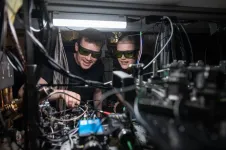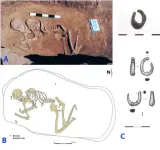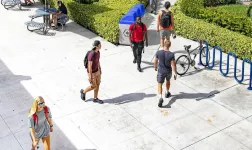(Press-News.org) University of Cincinnati experts will present research at the International Stroke Conference 2025 in Los Angeles.
Study finds small number of patients eligible for new ICH treatment
Intracerebral hemorrhage (ICH), when there is bleeding into brain tissue from the rupture of a damaged blood vessel, is one of the most devastating types of stroke. Patients often suffer from severe neurologic disability or even death. There were no proven treatments for patients with ICH until recently.
“We now have one study that showed removing the blood in the brain tissue with a minimally invasive procedure improves quality of life for patients with intracerebral hemorrhage,” said Paul Wechsler, MD, vascular neurology fellow at the UC College of Medicine and a UC Gardner Neuroscience Institute physician. “However, only specific patients are eligible for this procedure.”
Wechsler and his colleagues examined data from patients with ICH from the Greater Cincinnati Northern Kentucky Stroke Study (GCNKSS) to estimate the number of patients who are eligible for this new procedure to remove blood in the brain. They found only approximately 3% of all patients with ICH in the study area would be eligible for the minimally invasive procedure.
“This is a very small number and leaves the majority of patients with intracerebral hemorrhage without treatment options,” Wechsler said. “Although it is exciting to offer this new minimally invasive procedure to help some patients with intracerebral hemorrhage, more research is urgently needed to find better treatments for more patients.”
Wechsler will present “Projecting United States Population Eligibility for Minimally Invasive Surgical Evacuation of Acute, Spontaneous Intracerebral Hemorrhage” Feb. 5 at 2 p.m. and “Eligibility for Minimally Invasive Surgical Evacuation of Acute, Spontaneous Intracerebral Hemorrhage: A Population-Based Study” Feb. 6 at 8:30 a.m.
Study: Black patients have worse outcomes after stroke
As research into stroke rehabilitation continues, there is still relatively little known about how much people can recover after a stroke or whether there are racial disparities in this recovery.
David Robinson, MD, and his colleagues looked at GCNKSS data to explore whether Black individuals experience worse disability after stroke compared to white individuals, and whether this changes over a one-year period.
“We found that Black individuals do have worse functional outcomes after ischemic stroke when compared with white individuals, even after adjustment for factors known to impact stroke recovery,” said Robinson, a UC Gardner Neuroscience Institute physician researcher and assistant professor in the Department of Neurology and Rehabilitation Medicine in UC’s College of Medicine. “Further, there was some evidence that this effect was more prominent at later follow-up periods, suggesting that there may be environmental, socioeconomic or other social determinants impeding stroke recovery in Black individuals.”
With the total number of strokes expected to rise, Robinson said, there is a need for more research of rehabilitation, recovery and how to address the social determinants that lead to racial disparities in recovery.
Robinson will present “Racial disparities in functional outcome after ischemic stroke” Feb. 5 at 6:05 p.m.
about Robinson’s research on racial disparities in stroke survival and recovery.
Different statistical methods can provide more precise, patient-centric results
Stroke physicians use a method called the modified Rankin score (MRS) to identify patient outcomes after an acute stroke. The scale goes from zero to 6, with each number representing different levels of symptoms and dependence, but generally a score of zero to 2 is considered a “good outcome” with 3 to 7 being a “bad outcome.”
This binary of outcomes is used, UC’s Eva Mistry said, to help calculate a metric called “number needed to treat,” which the Food and Drug Administration (FDA) considers when approving therapies.
“‘Number needed to treat’ just means how many patients you need to treat with a given therapy to get a better outcome in one patient, and basically looks at how powerful a therapy is,” said Mistry, MBBS, associate professor and vice chair of research in the Department of Neurology and Rehabilitation medicine in UC’s College of Medicine and a UC Gardner Neuroscience Institute physician researcher. “That is the reason why we divide more granular and patient-centered outcomes into binary yes-or-no outcomes — because that traditionally has been the only way you can calculate the number needed to treat.”
Studying previous methods and a newly designed method, Mistry and her team showed the number needed to treat can be calculated for each level in the MRS rather than the binary of good or bad outcome.
“Even a one-level-better outcome on a scale of seven levels can be meaningful benefit from a patient’s perspective,” Mistry said. “This is a more patient-centric way to understand the number needed to treat for outcomes that are distributed across a scale like that.”
Mistry said the goal of this research is for the scientific community and other stakeholders to understand the possibility of using these different methods moving forward.
“You don’t need to ask the field to reduce this beautiful outcome into two categories,” Mistry said. “Even if the patient improved one level, we count that as a win. And if you do it that way, the number needed to treat is almost always less.”
Mistry will present “Comparative analysis of methods to derive number needed to treat over the entire range of global disability on the modified Rankin Scale” Feb. 5 at 6:20 p.m.
Study evaluates reliability of administrative codes in stroke research
Researchers often use administrative data, such as ICD-10 codes used for insurance claims, to study clinical events like stroke because this data is more cost-effective and readily accessible than other methods.
But despite widespread use of ICD-10 codes in research, the validity of this technique has been examined infrequently. Researchers led by UC’s Laura Gutierrez Quiceno, MD, evaluated the reliability of ICD-10 codes using data from the GCNKSS.
“ICD-10 standard codes designated for both acute ischemic strokes and hemorrhagic strokes demonstrated moderate sensitivity along with a reasonable positive predictive value for acute ischemic strokes and a moderate positive predictive value for hemorrhagic strokes,” said Gutierrez Quiceno, a neurology and neurocritical care fellow in UC’s College of Medicine and a UC Gardner Neuroscience Institute physician. “These findings indicate that ICD-10 codes can serve as a validated method for identifying incident stroke events, providing a foundation for their use in future research.”
Moving forward, researchers will assess whether these findings can be generalized outside the United States, as Gutierrez Quiceno noted that large cohorts in clinical studies are frequently associated with international collaborators.
Gutierrez Quiceno will present “Reliability of ICD-10 codes for Stroke in a Representative US Population” Feb. 5 at 6 p.m.
Researchers examining cause of racial differences in post-stroke feeding tube placement
Up to three-quarters of all stroke survivors have some form of difficulty swallowing (dysphagia) after a stroke. Dysphagia can result in entry of food or liquid into the lungs and significantly impacts patients’ overall health and quality of life.
For some patients with dysphagia, doctors need to place a feeding tube, known as percutaneous endoscopic gastrostomy or a PEG, to ensure adequate nutrition. When used long term, a PEG can cause various complications.
Previous literature shows that placing a PEG is more common in Black patients than white patients after a stroke, but it is unclear why. Brittany Krekeler, PhD, and her colleagues reviewed 2010, 2015 and 2020 data from the GCNKSS to evaluate the influence of patient-related factors and stroke characteristics on PEG placement.
“Patient characteristics such as age, prior stroke and stroke severity, and socioeconomic situation do not seem to be contributing to this racial difference in PEG placement,” said Krekeler, assistant professor and clinician-scientist at the UC College of Medicine’s Dysphagia Rehabilitation Laboratory. “In future work, we need to examine if other social factors could be driving this difference, such as patient preference, support, education level and health literacy, to better serve our patients in the informed decision-making process around feeding tube placement.”
Krekeler will present “Racial Differences in Percutaneous Endoscopic Gastrostomy (PEG) Placement in Post-Stroke Dysphagia” Feb. 5 at 7 p.m.
Method identified to best measure CST lesion load, predict motor recovery
Measuring stroke lesion load on the corticospinal tract (CST) — or determining how much of the tract is affected by the stroke — helps predict motor function and recovery after a stroke. But there are several methods to measure CST lesion load, and it was previously unclear which measurement tool was best at predicting motor outcomes during recovery.
Brady Williamson, PhD, and colleagues compared four measurement methods and found a measurement called maximum weighted lesion load to be the best predictor of outcomes.
“This is the point of the tract with the maximum overlap with the lesion weighted by the diameter of the tract at that point,” said Williamson, assistant professor in the Department of Radiology in UC’s College Medicine. “Weighting is important, as a similar overlap affects far more nerve fibers when the tract is compact than when it is spread out.”
Additionally, the team found that using age-matched data for healthy comparison groups — 50 to 80 years old for stroke populations — improves the ability of maximum weighted lesion load to predict motor outcomes compared to more generic data from varied age groups.
Williamson and his colleagues are continuing the research in two directions. First, they are comparing the effectiveness of maximum weighted lesion load to tractography-based methods.
“Tractography is a more direct measure of white matter, so our hypothesis is that this will provide an even better metric of lesion load,” he said. “However, the drawback is that the data needed to do tractography is not always feasible to obtain clinically.”
Second, the team will apply maximum weighted lesion load measurement to patients enrolled in the VERIFY stroke recovery study as part of a scoring algorithm to predict which patients will recover motor function after stroke.
Williamson will present “Optimizing the Approach to Calculating CST Lesion Load for Understanding Motor Outcomes” Feb. 5 at 6:05 p.m.
Electronic consent associated with higher acute stroke trial enrollment
With every second counting during an acute ischemic stroke, obtaining timely informed consent is a key barrier when recruiting for clinical trials. Electronic consent (eConsent) allows electronic delivery and documentation of the informed consent process, which may optimize recruitment, but UC’s Iris Davis said its utilization in acute ischemic stroke trials is limited and understudied.
Davis and colleagues conducted a post hoc analysis of eConsent adoption in the Phase 3, multicenter MOST trial to evaluate potential associations with recruitment, participant demographics, timeliness and informed consent documentation adherence.
“eConsent in MOST was associated with higher individual site enrollment, higher remote consent rates and improved consent documentation adherence over paper consent,” said Davis, clinical research manager and NIH StrokeNet administrative codirector. “Our study outlines the potential advantages of eConsent adoption in future acute ischemic stroke clinical trials and stroke research networks.”
Davis said the most notable limitation of the study was that eConsent adoption in MOST was voluntary, and there are likely inherent differences between sites that used eConsent and those that did not.
Davis will present “The Impact of Electronic Consent on Participant Recruitment in an Acute Ischemic Stroke Clinical Trial” Feb. 5 at 7 p.m.
Ongoing trials
UC researchers will also present poster updates on several ongoing clinical trials, including:
VERIFY, a large-scale multicenter study examining whether certain biomarkers can predict the likelihood that a patient will recover motor functions following a stroke. Kalli Beasley, MPH, will present “Validation of Early Prognostic Data for Recovery Outcome after Stroke for Future, Higher Yield Trials (VERIFY) Study” Feb. 6 at 7 p.m.
FASTEST, a trial studying the effectiveness of a drug to help “plug the leak” of bleeding in the brain from intracerebral hemorrhage. Joseph Broderick, MD, will present “Recombinant Factor VIIa (rFVIIa) for Acute Hemorrhagic Stroke Administered at Earliest Time (FASTEST) Trial” Feb. 6 at 7 p.m.
SISTER, a trial testing the efficacy of a new monoclonal antibody to treat acute ischemic stroke patients up to 24 hours after symptom onset. Mistry will present “Strategy for Improving Stroke Treatment Response (SISTER): A Phase-2 Clinical Trial of TS23, a novel mechanism for improving outcomes in acute ischemic stroke” Feb. 6 at 7 p.m.
TESTED, a trial examining the effectiveness of a stroke treatment for patients with a pre-stroke disability, one of the first studies to focus on this population. Mistry will present “Treatment with Endovascular Intervention for Stroke Patients with Existing Disability (TESTED): A Comparative Effectiveness Study” Feb. 6 at 7 p.m.
Other UC involvement at ISC includes:
Brett Kissela, MD, and Pooja Khatri, MD, serving as panelists during the session “HEADS-UP: Health Equity and Actionable Disparities in Stroke: Understanding and Problem-solving” on Feb. 4.
Natalie Kreitzer, MD, moderating the session “Under Pressure: How to Treat Blood Pressure in the Ambulance and in the ED” Feb. 4 at 915 a.m.
Mistry presenting “Optimal Blood Pressure Management in Acute Cerebrovascular Disease” Feb. 5 at 9:15 a.m.
Robert Stanton, MD, presenting “Stroke Incidence by Race in a Large, Biracial Population Over Time: 2020 Update” Feb. 5 at 2:36 p.m.
Ian Yahnke, MD, presenting “Population-based Study of Stroke Recurrence in Overweight or Obese Patients: Considerations for Future Prevention Trials” Feb. 5 at 7 p.m.
Mistry presenting “Patient And Partner Engagement In Acute Stroke Research” Feb. 6 at 3:50 p.m.
Pooja Khatri, MD, serving as a panelist during the session “75 Years of NINDS-supported Research to Advance Stroke Prevention, Treatment, and Recovery: From Bench to Bedside and Beyond” Feb. 6 at 5:05 p.m.
Yasmin Aziz, MD, presenting “Large Vessel Occlusion Stroke in A Population: Prevalence, Presenting Characteristics, Treatment, and Mortality” Feb. 6 at 7 p.m.
Khatri presenting the poster “NIH StrokeNet” Feb. 6 at 7 p.m.
Pooneh Nabavizadeh, MD, presenting “Transthoracic Echocardiographic Findings in Cryptogenic Stroke: Prevalence and Comparisons to Other Subtypes of Ischemic Stroke” Feb. 6 at 7 p.m.
Robert Stanton, MD, presenting “Observed to Expected Sex and Racial Makeup of Trial Participants in Completed StrokeNet Trials” and “Predicting Hemorrhagic Transformation After Thrombolytics with Computed Tomography using a 3D Convolutional Neural Network” Feb. 6 at 7 p.m.
Khatri presenting “Thrombolysis in Mid Stroke” Feb. 7 at 7:45 a.m.
Khatri presenting “Creating StrokeNet and Centers of Excellence in the United States” Feb. 7 at 9:15 a.m.
END
University of Cincinnati experts present research at International Stroke Conference 2025
Abstracts examine treatment eligibility, racial disparities, new statistical methods and more
2025-02-05
ELSE PRESS RELEASES FROM THIS DATE:
Physicists measure a key aspect of superconductivity in “magic-angle” graphene
2025-02-05
Superconducting materials are similar to the carpool lane in a congested interstate. Like commuters who ride together, electrons that pair up can bypass the regular traffic, moving through the material with zero friction.
But just as with carpools, how easily electron pairs can flow depends on a number of conditions, including the density of pairs that are moving through the material. This “superfluid stiffness,” or the ease with which a current of electron pairs can flow, is a key measure of a material’s superconductivity.
Physicists at MIT and Harvard University have now directly measured superfluid stiffness for the first time ...
Study in India shows kids use different math skills at work vs. school
2025-02-05
In India, many kids who work in retail markets have good math skills: They can quickly perform a range of calculations to complete transactions. But as a new study shows, these kids often perform much worse on the same kinds of problems as they are taught in the classroom. This happens even though many of these students still attend school or attended school through 7th or 8th grades.
Conversely, the study also finds, Indian students who are still enrolled in school and don’t have jobs do better on school-type math problems, but they often fare poorly at the kinds of problems that occur in marketplaces.
Overall, both the “market kids” and the “school kids” ...
Quantum algorithm distributed across multiple processors for the first time – paving the way to quantum supercomputers
2025-02-05
UNDER EMBARGO UNTIL 16:00 GMT / 11:00 ET WEDNESDAY 5 FEBRUARY 2025
Quantum algorithm distributed across multiple processors for the first time – paving the way to quantum supercomputers
In a milestone that brings quantum computing tangibly closer to large-scale practical use, scientists at Oxford University Physics have demonstrated the first instance of distributed quantum computing. Using a photonic network interface, they successfully linked two separate quantum processors to form a single, fully connected ...
Why antibiotics can fail even against non-resistant bacteria
2025-02-05
Antibiotics are indispensable for treating bacterial infections. But why are they sometimes ineffective, even when the bacteria are not resistant? In their latest study published in the journal Nature, researchers from the University of Basel challenge the conventional view that a small subset of particularly resilient bacteria are responsible for the failure of antibiotic therapies.
In certain infectious diseases caused by bacteria, antibiotics are less effective than expected. One example is infections caused by Salmonella bacteria, which can lead to illnesses such ...
Missing link in Indo-European languages' history found
2025-02-05
Where lies the origin of the Indo-European language family? Ron Pinhasi and his team in the Department of Evolutionary Anthropology at the University of Vienna contribute a new piece to this puzzle in collaboration with David Reich's ancient DNA laboratory at Harvard University. They analyzed ancient DNA from 435 individuals from archaeological sites across Eurasia between 6.400–2.000 BCE. They found out that a newly recognized Caucasus-Lower Volga population can be connected to all Indo-European-speaking populations. The new ...
Cancer vaccine shows promise for patients with stage III and IV kidney cancer
2025-02-05
Boston – Dana-Farber Cancer Institute researchers report that all nine patients in a clinical trial being treated for stage III or IV clear cell renal cell carcinoma (a form of kidney cancer), generated a successful anti-cancer immune response after initiation of a personalized cancer vaccine. The vaccines were administered after surgery to remove the tumor and are designed to train the body’s immune system to recognize and eliminate any remaining tumor cells. At the time of data cut-off (median of 34.7 months), ...
Only seven out of 100 people worldwide receive effective treatment for their mental health or substance-use disorders
2025-02-05
New research estimates that globally, only 6.9 per cent of people with mental health or substance-use disorders receive effective treatment for their disorders.
Researchers from the University of British Columbia and Harvard Medical School analyzed survey data from nearly 57,000 participants in 21 countries collected over a 19-year period, to provide the clearest picture yet of where people discontinue their path to effective treatment for nine common anxiety, mood and substance-use disorders.
The biggest barrier to effective ...
Ancient engravings shed light on early human symbolic thought and complexity in the levantine middle palaeolithic
2025-02-05
New study demonstrates that certain incised stone artefacts from the Levantine Middle Palaeolithic, specifically from Manot, Qafzeh, and Quneitra caves, were deliberately engraved with geometric patterns, indicating advanced cognitive and symbolic behaviour among early humans. In contrast, artefacts from Amud Cave, with shallow and unpatterned incisions, are consistent with functional use. This research highlights the intentionality behind the engravings, providing key insights into the development of abstract thinking and the cultural complexity of Middle Palaeolithic societies.
Link ...
The sexes have different strengths for achieving their goals
2025-02-05
Many factors are needed to achieve our goals. Now researchers have looked at passion, drive and people’s ability to find flow.
“This is the first study to look at these factors together,"says Professor Hermundur Sigmundsson at the Norwegian University of Science and Technology (NTNU’s) Department of Psychology.
The researchers have found differences between the sexes. The results indicate that the sexes each have their own strengths when it comes to success.
Men are more passionate than women when it comes to achieving their goals. They also often have an easier time finding flow.
Women, ...
College commuters: Link between students’ mental health, vehicle crashes
2025-02-05
Young adults are a higher risk group for being in a crash while driving due likely to inexperience with driving, driving under the influence, and a greater propensity to take risks while driving. Although research has explored sociodemographic links of driver crashes based on age, sex and socioeconomic status, reports on the relationship between crashes and mental health are sparse.
A new Florida Atlantic University study fills a notable gap by exploring the correlation between commuter college students’ mental health status and being in a crash while driving. Commuter students, often lower-income, older, or balancing family responsibilities, face greater ...
LAST 30 PRESS RELEASES:
Norbert Holtkamp appointed director of Fermi National Accelerator Laboratory
New agentic AI platform accelerates advanced optics design
Biologists discover neurons use physical signals — not electricity — to stabilize communication
Researchers discover that a hormone can access the brain by hitchhiking
University of Oklahoma researcher awarded funding to pursue AI-powered material design
Exploring how the visual system recovers following injury
Support for parents with infants at pediatric check-ups leads to better reading and math skills in elementary school
Kids’ behavioral health is a growing share of family health costs
Day & night: Cancer disrupts the brain’s natural rhythm
COVID-19 vaccination significantly reduces risk to pregnant women and baby
The role of vaccination in maternal and perinatal outcomes associated with COVID-19 in pregnancy
Mayo Clinic smartwatch system helps parents shorten and defuse children's severe tantrums early
Behavioral health spending spikes to 40% of all children’s health expenditures, nearly doubling in a decade
Digital cognitive behavioral treatment for generalized anxiety disorder
Expenditures for pediatric behavioral health care over time and estimated family financial burden
Air conditioning in nursing homes and mortality during extreme heat
The Alps to lose a record number of glaciers in the next decade
What makes a good proton conductor?
New science reporting guide published for journalists in Bulgaria
New international study reveals major survival gaps among children with cancer
New science reporting guide published for journalists in Turkey
Scientists develop a smarter mRNA therapy that knows which cells to target
Neuroanatomy-informed brain–machine hybrid intelligence for robust acoustic target detection
Eight SwRI hydrogen projects funded by ENERGYWERX
The Lundquist Institute and its start-up company Vitalex Biosciences Announces Strategic Advancement of Second-Generation fungal Vaccine VXV-01 through Phase 1 Trials under $40 Million Competitive Con
Fine particles in pollution are associated with early signs of autoimmune disease
Review article | Towards a Global Ground-Based Earth Observatory (GGBEO): Leveraging existing systems and networks
Penn and UMich create world’s smallest programmable, autonomous robots
Cleveland researchers launch first major study to address ‘hidden performance killer’ in athletes
To connect across politics, try saying what you oppose
[Press-News.org] University of Cincinnati experts present research at International Stroke Conference 2025Abstracts examine treatment eligibility, racial disparities, new statistical methods and more





